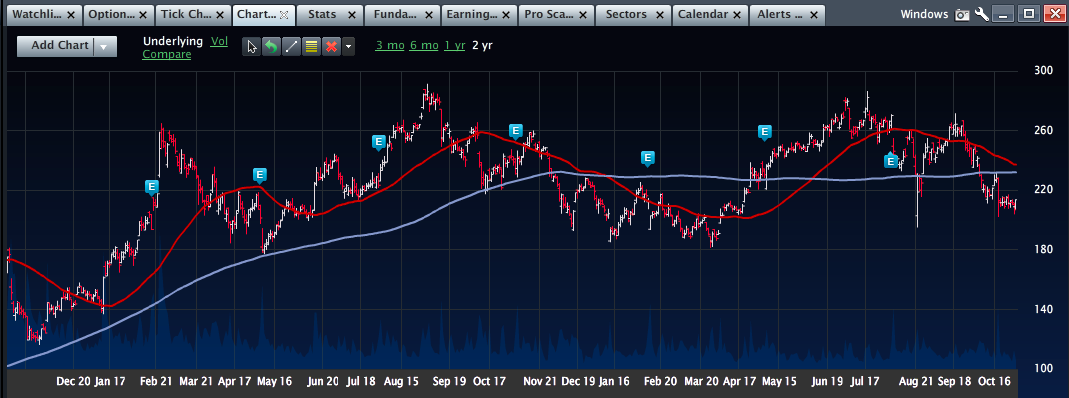You’ve heard the adage, “there’s more than one way to skin a cat”. Why you ever have to consider more than one way to accomplish this morbid task has always confused me, but that’s beside the point.
The point is that this rings true in the options markets on a daily basis. Let’s suppose we wanted to make a play on earnings for Elon Musk’s electric car company, Tesla Motors (TSLA). If I were going to play this, it would have to be to the downside. This company, no matter how cool, couldn’t turn a profit with oil above $80, how is he going to do with super cheap oil now? The technology at this point just is not cost effective. The chart backs this as assertion up:

Not exactly exhibiting a strong trend here. Next, we can look at how it’s performed over the past two years or so. We see that it has moved up 50% of the time and down 50% of the time. What’s different is that the down-moves are much greater in magnitude. So, if I can construct the proper reward to risk, a directional play (albeit risky) may make some sense. The average move for TSLA on earnings is 7.4% over the last two years. We will use weekly options here expiring Friday 11/6/2015. We know using Friday’s implied volatility and the underlying price for TSLA of $214.10 (at the time of this writing) to compute that the options market is projecting a move of about 8% to 10.5%. This targets 191.50 to 197.00 in price terms. How to play it? There are many but let’s highlight two.
Both will target the $195 strike. We can do the 11/6/15 190/195/200 put butterfly for approximately $0.30. You can lose only $0.30 (what you paid for the spread) and can profit $4.70! Fantastic reward to risk! Let’s also take a look at the 11/6/2015 192.5/195/200 “broken-wing” put butterfly where you have to pay $0.75. You can still only lose what you pay ($0.75) and can make $4.25. So, why in the world would you ever do the broken-wing? You pay more than twice in premium with the max profit being less. What if you are wrong in your target area? It was a pretty broad range (191.50 – 197.00). Let’s say you go to the lower end of range, which is totally possible and go to 191.50? With your conventional butterfly you would make $0.70. Your 190 puts are worthless, your short 195 puts are $4 (each) against you and your long 200 puts are $9 in the money. If you did the broken-wing butterfly, your 195s and 200s are worth the same but now your192.5s are worth $1.50 in your favor for a net profit of $1.75. You could take the more extreme assumption that we blow through all of our strikes at which point your regular butterfly is actually a $0.30 loser and your broken-wing is still worth $1.75. There is nothing more frustrating than having a directional trade on correctly and ultimately losing money! It all comes down to a matter of style at that point. As long as you are consistent with your approach, it’s a long-term trading plan that can work.




